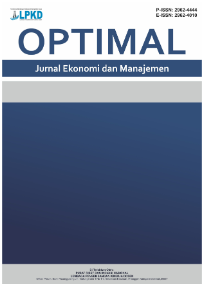Forecasting dan Analisis Ekonomi Usia Harapan Hidup Indonesia: Implikasi Strategis untuk Indonesia Emas 2045
DOI:
https://doi.org/10.55606/optimal.v5i2.5788Keywords:
ARIMA, Forecasting, Golden Indonesia 2045, Health economics, Life expectancyAbstract
This study analyzes the projection of Indonesia’s life expectancy up to the year 2045 and its strategic implications for economic development toward achieving the Golden Indonesia 2045 vision. Using the ARIMA forecasting model processed through EViews software, based on data from BPS and the World Bank for the period 1996–2024, the best model was identified as ARIMA (1,1,1), with an AR(1) coefficient of 0.197, MA(1) of -0.612, a constant of 0.380, and statistically significant standard error (p < 0.05). The forecasting results indicate that Indonesia’s LE will increase by an average of 0.75 years annually, reaching approximately 79.03 years by 2045. While this improvement reflects the success of public health efforts, it also introduces structural challenges, such as increasing fiscal burdens and rising demand for elderly care services. From an economic perspective, this trend offers both risks and opportunities. If managed strategically — through health investment as human capital, pension system reform, encouraging elderly participation in the workforce, and transforming healthcare-related service sectors — the increasing LE can serve as a key driver of inclusive and sustainable economic growth. This study recommends that the Indonesian government adopt inclusive, evidence-based public policies to harness the remaining demographic dividend and prepare for the transition toward an aging society, ensuring progress toward the Golden Indonesia 2045 vision.
Keywords: Forecasting, Life expectancy, Golden Indonesia 2045, ARIMA, Health economics
References
Asher, M. G., & Bali, A. S. (2019). Financing social protection in developing Asia: Issues and challenges. Asian Development Review, 36(1), 1–22. https://doi.org/10.1162/adev_a_00128
Bloom, D. E., Canning, D., & Sevilla, J. (2018). Health and economic growth: Reconciling the micro and macro evidence. Journal of Economic Literature, 56(3), 607–682. https://doi.org/10.1257/jel.20160955
Bloom, D. E., Kuhn, M., & Prettner, K. (2015). The contribution of female health to economic development. The Economic Journal, 125(582), 709–750. https://doi.org/10.1111/ecoj.12151
Eggleston, K. N., & Fuchs, V. R. (2018). The new demographic transition: Most gains in life expectancy now realized late in life. Journal of Economic Perspectives, 26(3), 137–156. https://doi.org/10.1257/jep.26.3.137
International Monetary Fund. (2019). Fiscal monitor: Curbing corruption. International Monetary Fund. https://www.imf.org/en/Publications/FM/Issues/2019/03/18/fiscal-monitor-april-2019
Kementerian Kesehatan Republik Indonesia. (2020). Laporan perkembangan COVID-19 di Indonesia. Kementerian Kesehatan RI. https://covid19.kemkes.go.id
Komnas Lansia. (2010). Strategi nasional kesejahteraan lanjut usia. Komnas Lansia.
Lee, R., & Mason, A. (2017). Cost of aging. Finance & Development, 54(1), 7–11. https://www.imf.org/external/pubs/ft/fandd/2017/03/pdf/lee.pdf
Mantra, I. B. (2000). Demografi umum. Pustaka LP3ES Indonesia.
Mils, A., & Gilson, L. (1990). Health economics for developing countries: A survival kit. World Health Organization.
Organisation for Economic Co-operation and Development. (2021). Promoting active ageing in the digital economy. OECD Publishing. https://doi.org/10.1787/active-ageing-2021-en
Sugiantari, N. L. P. (2013). Analisis angka harapan hidup di Provinsi Bali tahun 2010. Jurnal Ekonomi Kesehatan Indonesia, 2(1), 45–53.
Utomo, B. (1985). Analisis kematian dan penyebab kematian di Indonesia. Badan Pusat Statistik.
Weil, D. N. (2014). Health and economic growth. In P. Aghion & S. N. Durlauf (Eds.), Handbook of economic growth (Vol. 2B, pp. 623–682). Elsevier. https://doi.org/10.1016/B978-0-444-53540-5.00006-8
World Bank. (2020). World development indicators: Health expenditure. World Bank. https://databank.worldbank.org/source/world-development-indicators
World Health Organization. (2020). Decade of healthy ageing: Baseline report. World Health Organization. https://www.who.int/publications/i/item/9789240017900
Downloads
Published
How to Cite
Issue
Section
License
Copyright (c) 2025 OPTIMAL Jurnal Ekonomi dan Manajemen

This work is licensed under a Creative Commons Attribution-ShareAlike 4.0 International License.








